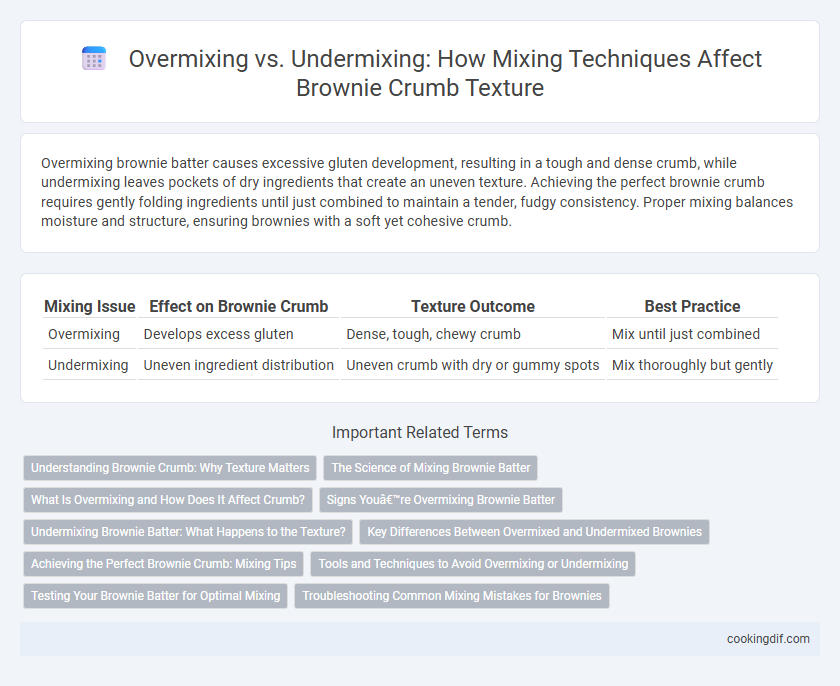Overmixing brownie batter causes excessive gluten development, resulting in a tough and dense crumb, while undermixing leaves pockets of dry ingredients that create an uneven texture. Achieving the perfect brownie crumb requires gently folding ingredients until just combined to maintain a tender, fudgy consistency. Proper mixing balances moisture and structure, ensuring brownies with a soft yet cohesive crumb.
Table of Comparison
| Mixing Issue | Effect on Brownie Crumb | Texture Outcome | Best Practice |
|---|---|---|---|
| Overmixing | Develops excess gluten | Dense, tough, chewy crumb | Mix until just combined |
| Undermixing | Uneven ingredient distribution | Uneven crumb with dry or gummy spots | Mix thoroughly but gently |
Understanding Brownie Crumb: Why Texture Matters
Brownie crumb texture is directly influenced by the mixing process; overmixing develops excessive gluten, resulting in a dense, chewy crumb, while undermixing leaves pockets of dry ingredients, causing uneven texture and dryness. Achieving the ideal balance ensures a tender, moist crumb with a slight fudgy consistency that enhances the overall sensory experience. Understanding the impact of mixing on the crumb helps bakers control texture precisely, creating brownies that meet desired quality standards.
The Science of Mixing Brownie Batter
Overmixing brownie batter causes excessive gluten development, leading to tough, chewy crumbs rather than the desired tender texture. Undermixing results in uneven ingredient distribution, creating dense pockets of flour and causing inconsistent crumb structure. Proper mixing balances gluten formation and ingredient integration, yielding a moist, fudgy crumb with a uniform texture.
What Is Overmixing and How Does It Affect Crumb?
Overmixing brownie batter causes excessive gluten development, resulting in a dense, tough, and chewy crumb rather than a tender texture. The additional air incorporated during overmixing can create large air pockets, leading to uneven crumb structure and potential crumb collapse. Maintaining careful mixing ensures a moist, tender brownie crumb with a uniform, fine crumb texture.
Signs You’re Overmixing Brownie Batter
Overmixing brownie batter causes excessive gluten development, resulting in a dense, tough crumb rather than a tender, fudgy texture. Signs of overmixing include a batter that appears glossy or stretchy and brownies that crack on the surface with a cakey, dry consistency. To achieve the ideal brownie crumb, mix the batter just until the ingredients are combined and no flour streaks remain.
Undermixing Brownie Batter: What Happens to the Texture?
Undermixing brownie batter results in unevenly distributed ingredients, creating pockets of flour and cocoa that produce a crumbly texture with dense, dry spots. This incomplete blending prevents proper gluten development and fat incorporation, leading to a gritty or coarse crumb rather than a smooth, fudgy bite. Careful mixing ensures a consistent, moist brownie crumb, avoiding the toughness caused by undermixing.
Key Differences Between Overmixed and Undermixed Brownies
Overmixed brownies develop a tough, dense crumb due to excessive gluten formation, resulting in a chewy texture rather than a tender bite. Undermixed brownies show uneven crumb and moist pockets, causing inconsistent texture and structural weaknesses. Achieving optimal mixing balances gluten development and ingredient integration, producing a uniformly moist, tender crumb with proper rise and texture.
Achieving the Perfect Brownie Crumb: Mixing Tips
Achieving the perfect brownie crumb requires precise mixing techniques to balance texture and moisture. Overmixing the batter develops excess gluten, resulting in a tough, dense crumb, while undermixing can leave pockets of dry flour and uneven texture. For a tender, fudgy brownie, gently fold ingredients just until combined, ensuring a uniformly moist and crumbly consistency without compromising structure.
Tools and Techniques to Avoid Overmixing or Undermixing
Using tools like a rubber spatula or wooden spoon allows better control over the mixing process, preventing overmixing brownie batter, which causes tough, dense crumbs. Techniques such as folding ingredients gently and mixing just until combined retain air pockets to ensure a tender, moist crumb. Avoid electric mixers for final blending steps to minimize the risk of overdevelopment of gluten and grainy textures in brownie crumb.
Testing Your Brownie Batter for Optimal Mixing
Testing your brownie batter for optimal mixing requires balancing overmixing and undermixing to achieve the perfect crumb texture. Overmixing causes excess gluten development, resulting in a tough, dense crumb, while undermixing leaves pockets of dry flour, creating uneven texture and crumbly brownies. Gently fold the ingredients until just combined and perform a quick texture check by lifting the spatula; the batter should be thick, smooth, and slightly glossy without streaks of flour for the ideal brownie crumb.
Troubleshooting Common Mixing Mistakes for Brownies
Overmixing brownie batter causes excessive gluten development, resulting in a tough, cake-like crumb that lacks the desired fudgy texture. Undermixing leaves pockets of dry flour and unevenly distributed ingredients, leading to dense, dry spots within the brownies. Achieving a uniform, glossy batter with just a few strokes after adding flour ensures a moist, tender crumb and even baking.
Overmixing vs Undermixing for Brownie Crumb Infographic

 cookingdif.com
cookingdif.com